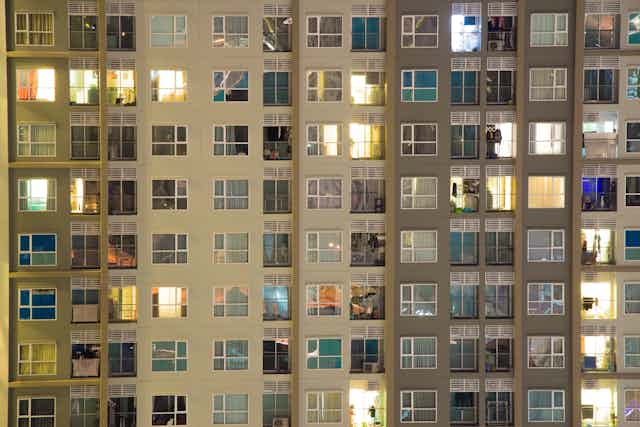This is the eighth article in our Contested Spaces series. These pieces look at the conflicting uses, expectations and norms that people bring to public spaces, the clashes that result and how we can resolve these.
Ethnic conflict is on the rise in Australia, with regular reports of racist abuse in public spaces, including transport, streets and shopping centres. But what about our more immediate domestic environments such as apartment buildings?
Our research shows that ethnic tensions can also play out within these buildings, where growing numbers of city dwellers now live.
As increasing diversity and density come to characterise our cities, how can we build harmonious communities within apartment complexes? Community relations programs have traditionally focused on neighbourhoods, local associations, sport and recreation activities, or schools. But as more and more of us move into apartments, we need to pay more attention to these super-local residential interactions.
Apartment complexes are microcosms of society, but living so close to strangers can increase the likelihood of tension. The flashpoints range from complaints about noise and garbage to disputes about levies and budgets. Cultural and language differences can exacerbate these conflicts.
What can we do with our closest neighbours to combat growing cultural tensions in society and improve community harmony? Here, drawing on our research, we reveal some top tips on how to build an inclusive and harmonious community in your apartment building.
Know thy neighbours
Social commentary on the loss of community abounds. As we become busier and more mobile, we are less and less likely to know our neighbours and our local community. However, a recent book highlighted the benefits of talking to strangers. This includes cementing relationships in the places where you live, work and play.
In our increasingly isolated societies, these local relationships are important. The same goes for our most immediate neighbours.
In addition to getting to know them face to face, you could ask your strata committee to do a quick survey of residents to get a better picture of the diversity among your neighbours. If many families of particular cultural groups live in your building, this knowledge can help you plan communication and events accordingly.
It may be that you have important notices translated, or arrange for neighbours to act as translators at meetings and relay information to others who may not speak English well. Or you can plan communal activities around festivities such as Christmas, Chinese New Year, Diwali or Eid.
Be a social butterfly

Doing things together is by far the most effective way to getting to know people. Invite your neighbours over for a cup of tea or, if all of you prefer, a glass of wine. But, remember, while sharing food can help you get to know one another, be considerate of people’s food choices, whether it’s for religious, ethical or other reasons; a barbecue of just pork sausages many not win many friends.
Invite neighbours to form working bees to do up the garden or decorate the hallways. But be culturally sensitive in your approach to building aesthetics. Don’t just put up decorations for Christmas or Easter; include other cultural events your neighbours celebrate. Or, if your building has a “no decorations” rule, make sure this applies universally and not just to Chinese New Year or Diwali ornaments.
Some apartment residents have successfully used social media such as Facebook groups or WhatsApp group chat to encourage communication in their buildings. This may be an easier method of communication for those with poor spoken English. Your residents survey may reveal other preferred forms of communication.
Singling out is never the right thing to do
While translating important documents will help your neighbours who may not have a good command of English, singling out specific language and cultural groups as potential wrongdoers (such as by translating “Do not do this” signage into one language only) may not only cause offence, but may be pointing the finger at the wrong party.
And leaving notes like the one below without first trying to find the culprit and speak with them about it may also damage relationships with your neighbours.

These are just some tips on how to start making your apartment building more harmonious and inclusive. Our project webpage has a longer list of these tips.
Help is also often at hand from other sources. The City of Sydney, for example, regularly holds workshops on how to live well in apartments for all parties. Likewise, peak bodies such as Strata Community Australia (NSW) produce fact sheets that not only update you on changes in regulations but also on ways to make your meetings run more smoothly.
Apartment living provides many opportunities to foster intercultural understanding, as residents increasingly share a domestic environment and work together to maintain their buildings. However, such close proximity can also amplify intercultural tension and hostility.
Fostering harmonious relations within high-density living is becoming increasingly important in creating socially cohesive, multicultural cities. We need to pay more attention to ideas and strategies for achieving this goal.
You can find other pieces published in the series here.

